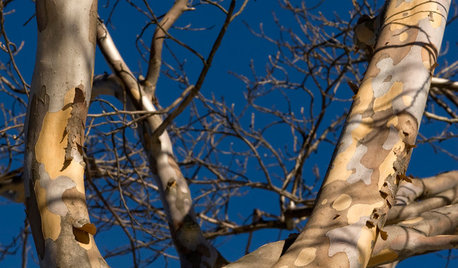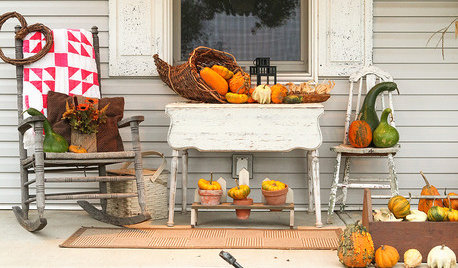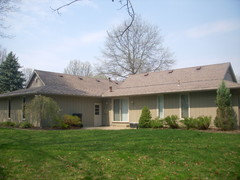Crape Myrtles And Cherry Trees For Northeast Ohio
cbmullen
8 years ago
last modified: 8 years ago
Featured Answer
Sort by:Oldest
Comments (27)
Related Discussions
crape myrtles
Comments (2)While not expert with CMs, I would guess that in the fall, as the CMs start to go dormant, you can dig them up and pot them. CMs are tough trees, even the dwarf ones, and should be able to cope with being moved into a pot. If you chose a fairly large pot, you can keep them in it for the next year, or you can replant them come spring. If leaving them in the ground means they freeze all their top-growth, since you say that they are dwarf anyway, so they won't grow into tall trees, cutting them back hard, if needed, should be fine. As a rule, I don't like the practice of trimming CMs back hard - I think topped trees are UGLY! But these, if they look like the ones I am familiar with, look more like shrubs anyway, not trees. They flower on new growth, so it shouldn't affect flowering. You could also treat a few as tender perennials, leaving them in the ground, wrapping them up well, like your roses, and hope they don't freeze all their top-growth. You could experiment and see what seems the best method - in ground or dug - or you can opt for safety and dig all of them, since you effectively DID the experiment this winter. Kept in an unheated garage or storage area, once they lose their leaves, and kept barely moist, they should be fine over the winter. You could then experiment to see if replanting them or leaving them in pots was the better method....See More'Royal Raindrops' crabapples and Crape Myrtles as street trees?
Comments (13)Thanks to everyone for the feedback. I'm just not ambitious and disciplined enough to maintain that many fruit trees on the parking strips, so I'm keeping my fingers crossed that the 'Royal Raindrops' crabapples will be approved. I may just plant one Crape Myrtle closer to the south side of the house to get more reflected heat. Thanks gardengal for the info on the 'Royal Raindrops' leaf color. I was hoping it would be more green. Our neighbors have two huge purple-leaf plums, and I wasn't that excited about that many purple-leafed trees around the house. I actually attended Arthur Lee Jacobson's talk at the NW Flower and Garden Show this year. He recommended Malus Tschonoskii crabapples, but WSU put it on their Discard list due to "ornamental only for its narrowly upright form, no showy flowers or fruit". I really want dark-pink spring flowers. Gardengal, do you know how showy the spring flowers are on the 'Royal Raindrops' you planted for your client? Also, Arthur Lee Jacobson doesn't have any info on the 'Royal Raindrops' since they're so new, but Urban Forest Nursery, which specializes in street and landscape trees, recommends it. Urban Forest Nursery Royal Raindrops Flowering Crab profile...See MoreTuscarora Crape Myrtle
Comments (3)As smivies said, it will probably be a dieback shrub, so no lovely trunk with its mottled bark, and perhaps a bit of a wild mound of sprounts each year if it survives. If that is OK with you, give it a try and report back to us how it does. Here's a thread on crape myrtles in southern New England. Most of the folks are 6b or zone7 on Cape Cod and along the southern shore of MA and RI....See MoreCrape Myrtles How to protect in Ohio
Comments (10)z5 is about half the Us.. and wildly variable .. as zone is basically only min winter temp ... if one night you get the same low temp.. youre in the same zone ... and in one area the ground freezes for 4 months.. and not in the other .. i suspect ... CMs will not tolerate ground freeze .. as i have never seen them in adrian.. 30 miles north of toledo ... regardless.. you have the plants.. so go for it .. rose cone is a plus.. on some level.. better than a sharp stick in the eye ... put it on. in mid to late november ..the key is get it dormant.. keep it dormant.. put it on too early .. and you MIGHT prolong onset of dormancy ... and remove it in late march or so ... you dont wnat the cone to trigger early growth ... with months of frost freeze potential ... to repeat: the key is get it dormant.. keep it dormant.. ken...See Morecbmullen
8 years agocbmullen
8 years agocbmullen
8 years agocearbhaill (zone 6b Eastern Kentucky)
8 years agocbmullen thanked cearbhaill (zone 6b Eastern Kentucky)cbmullen
8 years agocbmullen
8 years agocbmullen
8 years agolast modified: 8 years agocbmullen
8 years agocbmullen
8 years agoarbordave (SE MI)
8 years agocbmullen
8 years agolast modified: 8 years agocbmullen
8 years agowisconsitom
8 years agolast modified: 8 years agocbmullen
8 years agocbmullen
8 years agolast modified: 8 years agorusty_blackhaw
8 years ago
Related Stories

GARDENING GUIDES5 Best-Behaved Trees to Grace a Patio
Big enough for shade but small enough for easy care, these amiable trees mind their manners in a modest outdoor space
Full Story
FALL GARDENING11 Trees for Brilliant Fall Color
Give your landscape the quintessential look of autumn with the red, orange and yellow leaves of these standouts
Full Story
GARDENING GUIDESGreat Design Plant: Sambucus Nigra
Common elderberry is a highly adaptable shrub from the eastern U.S., with berries galore for wildlife and humans alike
Full Story
TREES7 Deer-Resistant Flowering Trees to Plant this Fall
If you live in a neighborhood with roaming deer, consider these beautiful trees that won't tempt hungry guests
Full Story
ARBOR DAY8 Reasons to Plant a Great Tree
Beauty is its own reward, but the benefits of planting the right tree in the right place go way beyond looks
Full Story
LANDSCAPE DESIGN7 Great Trees for Summer Shade and Fall Color
These landscape-pro faves straddle the seasons beautifully. Could one enhance your own yard?
Full Story
WINTER GARDENING8 Gorgeous Trees for Winter Interest in the Garden
Intriguing forms and beautiful branches take center stage when color heads back into the wings of the winter landscape
Full Story
PORCHESA Peek at 2 Prettily Dressed Fall Porches
Pumpkins, fall flowers and flea market finds help two Ohio porches get into the seasonal spirit
Full Story
TREES11 Japanese Maples for Breathtaking Color and Form
With such a wide range to choose from, there’s a beautiful Japanese maple to suit almost any setting
Full Story
LANDSCAPE DESIGNSmall Garden? You Can Still Do Bamboo
Forget luck. Having bamboo that thrives on a wee plot just takes planning, picking the right variety, and keeping runners in check
Full Story





Toronado3800 Zone 6 St Louis